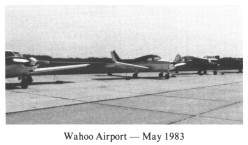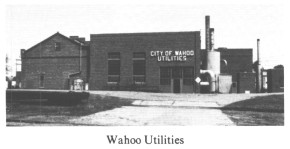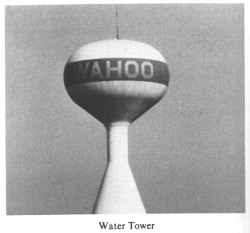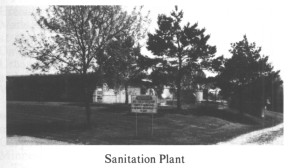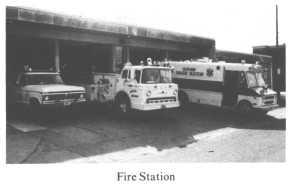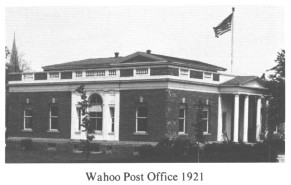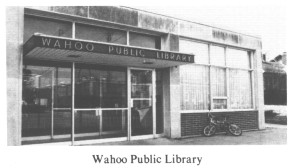 |
STOCKING PRECINCT |
WAHOO SEWER SYSTEMA need for public sewer drainage became apparent in 1898 when people were warned not to throw slops into the gutter. The local laundry was causing sewage to be running in the street in the business district. The City Attorney was instructed to notify these people to abate all nuisances in regard to wastewater. Problems with private cesspools were investigated and finally in 1904 a special election to issue $15,000 bonds to establish a sewer system was passed, 253 for and 104 against. Matt & Huntington Contractors of Independence, Mo. were awarded a contract to install 25,555' of pipe, 257' of manholes and 4 tanks for automatic flushing. This sewer work was very extensive and many problems occured. Some had to be relaid because it wasn't installed to grade and profile. Winter hit with ditches open. The engineers made several changes and the project was finally completed in June, 1906. In the years following private sewer connections were gradually made and sewer extension in to new developments was expanded. The sewage emptied into Wahoo Creek south of C Street until 1965 when a $16,0000 Sewer Wastewater Treatment Plant was built south of C Street and Elm to follow federal regulations against raw sewage dumping into open streams. The plant is adequate in size for several years and other than maintenance and updating, no further improvements have been made. The plant operator was Ralph Gilliam until 1980 when George Christian became operator. It is under the direction of the Light and Water Commissioner. A storm sewer project was proposed in 1919 and again in 1926 but both times rejected. As paving has been installed storm sewers have been put in. More improvements are needed and plans are projected for 1985 or 1986 to be completed along with a new highway project through the City that is proposed to be done at that time. A suitable site for a garbage dump was first mentioned in May, 1891. Various sites were discussed and used through the years. The present landfill site has been used for at least 35 years and in 1976 the site was purchased from Vernon and Helen Schmidt for this purpose.
WAHOO FIRE DEPARTMENTOn July 27, 1878, the Wahoo City Council took formal action to provide fire protection for the City of Wahoo. The Fire Committee was one of the first formed when the City incorporated in 1870. The first equipment purchased in 1878 were two No. 5 Champion Chemical Fire Engines and one No. 3 Hook and Ladder Truck. The Council ordered City Bonds in the amount of $2,000 to be issued to pay for this equipment. The original Fire Dept. Engine Co. (Hose Co. No. 1) was formally organized August 22, 1878. At this time, all of the fire equipment was pulled by hand and housed in the Old City Hall. In 1910 horses were purchased to pull the fire equipment. The first motorized fire truck was purchased for $400 on March 9, 1917, to be used by Hose Co. No. 2. In October 1923, Wahoo purchased its first motorized fire pumper. In 1929, the first siren was purchased for use as a signal. Prior to that time, a bell in the tower of the City Hall was rung.
In 1941 the Rescue Squad was organized which is staffed by select members of the Fire Department and serves the Wahoo area with emergency medical service. The Wahoo Fire Department has a total of 45 members which make up three companies, Hose Co. No. 1, Hose Co. No. 2 and the Hook and Ladder Co. The present officers are: Fire Chief, Don Jelinek; 1st Assistant, Tom Massie; 2nd Assistant, Robert Virgl; and Rescue Squad Captain, Ronald Voboril. The equipment is kept up to date and good mechanical condition.
WAHOO POST OFFICEThe Wahoo Post Office is located on Fifth Street between Broadway and Linden Streets, and faces Fifth Street. The United States Congress purchased this site in 1913. The building was completed in 1918 at a cost of $50,000. It has been remodeled several times and additions have been made. The most recent remodeling was completed in August, 1964. The present postmaster is Don A. Swift. Merlin Hall is the supervisor of Postal Operations. Rural Mail Carriers are: Robert J. Norenberg, Rte. 1; Daryl W. Anderson, Rte. 2; and Reuben E. Caha, Substitute Carrier. City carriers are Kenneth Carlson, City 1; Edward L. Kontos, City 2; Joseph J. Voboril, City 3; and Julius E. Izso. Post Office clerks are Reinhart L. Miller, William P. Iversen, and Quanita A. Shanahan. WAHOO PUBLIC LIBRARYThe Wahoo Public Library was established in February, 1923. It was a project of the Wahoo Woman's Club. The first Library was on the second floor of the Old City Hall. Although the original library was started with funds from gifts and benefactions, it is now tax supported. The present building which now houses the library was completed in 1960. The circulation is over 30,000 books for a year. Many new books are added to the collection each year. The library today has over 22,000 hardbound and paperback books.
The past years have seen many improvements and additions to the library. Not only does the library have books, but records, newspapers, magazines and a large print book collection are available. A copy machine may be used by the patrons. Each summer a story hour and reading program is held for the small children. The library is a very important part of the educational resources in the community. The first librarians were volunteers. Mrs. Grace Oldham was the first to receive a salary. The following have served as head librarians, Miss Mona Stein, Mrs. Conrad Magnussen, Mrs. John Koenig and the present librarian Mrs. Leo H. Smith, assisted by Mrs. John Gross Jr. and Mrs. Bill Pearson. The ladies on the board at the time of the dedication of the new library were Mrs. I.M. Thompson, Mrs. Gerald Erickson, Mrs. Audrey Williams, Mrs. Everett Barry and Mrs. Robert Edstrom. Present board members are Mrs. J.D. Little, Miss Flora K. Ewart, Mrs. Merton Oden, Mrs. Sam Martin and Mr. Robert Sullivan. The Wahoo Public Library was dedicated to "the pioneers who came and stayed." The pioneers would be proud of this outstanding facility. NATIONAL REGISTERThe Howard Hanson House, a white frame Victorian house at the corner of 12th and Linden Streets in Wahoo, has been added to the National Register of Historic Places Jan. 27, 1983. The Hanson House was the birthplace and home of the nationally known composer and educator Howard Hanson. The House serves as a repository for artifacts and documents relating to the Five Famous Sons of Wahoo. The house was restored to an 1890 appearance and was opened to the public in 1967. Many tourists have visited this house, the home of the famous Howard Hanson. PARKSIn June, 1886, Councilman Lepsa and Collins were appointed to look up the matter of a city park for Wahoo. In July they reported that Mr. Stocking had been contacted and wanted $2,500 for 12 acres of land near the Hadsall Bridge. No action was taken, except that the Council smiled and adjourned, as noted in the minutes by the City Clerk. The subject of parks was not brought up again until 1919 when David H. Mills deeded the sand pit property in Block 127, 111 and 112 for public and municipal purposes. The gravel pit was still in operation and the City agreed that any income over $500 would be used for the sole purpose of making, establishing and maintaining a public park. Gravel was used on city streets and remained in operation until 1927. The south part of Lots 11 and 12 in Block 137 at 6th and Broadway was purchased in 1890 from Lenore Perky for the new city hall. The north part of these lots were purchased in 1922 from Oscar and Kittie Lindercamp for $1,400 and paid for by the Park Fund. This vacant lot remained as such until the present City Hall was erected in 1959. The Mills family operated Mills Park east of town on the banks of Sand Creek. The city rented a portion of this park for tourist camping in the early 1920s. Across the road was the very popular Wanahoo Park which was developed in 1920. The city installed electric lights and a sidewalk from the city out to these parks along the south side of the road. Wanahoo Park had a dance pavillion, water wheel, boating, picnic grounds and swimming pool. The City began to acquire property in the City Park block in 1919 in a rather piece-meal fashion. Lot 4 was purchased from L.J. and Mary Kudrna, Lot 7, 8, 9, 10, 11 and 12 from August Gustafson, Lots 1 and 2 from John Nelson, and Lot 3 and Lots 7, 8 and 9 in Block 157 to the east from Wm. and Alvina Hapke. The Gustafson lots had a house on it and for a few years the boy scouts and girl scouts used this house as their meeting place. Much of the City Park had been a ravine so in the early years, all good excess dirt that became available was filled in here. When the Methodist Church was built in 1922, excess dirt was purchased for 25¢ a load. page 123 |
| Back | Contents | Next |
The Saunders County NEGenWeb Project
